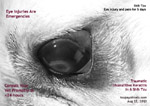Veterinary Trends In
Singapore
Dr Sing Kong Yuen, BVMS (Glasgow), MRCVS
Date:
06 May, 2011 |
 toapayohvets.com toapayohvets.com
Be Kind To Pets
Veterinary Education
Project 2010-0129 |
SOME INTERESTING
OBSERVATIONS AND COMPARISONS
Vets are equivalent to General Practitioners (GPs) in
Singapore as both have first degrees. However, the Singapore
GP have to compete with the subsidized health care at
Polyclinics.
Some facts and figures from The Straits Times, April 25, 2011
- Let GPs handle the poor and polyclinics the elderly.
1. There are 1,600 GP clinics compared to over 45 veterinary
clinics in 2011.
2. The PCPS is introduced by the Ministry of Health (MOH) 10
years ago for elderly patients to see a GP in a private clinic
but pay subsidized polyclinic rates. The GPs get paid by the
MOH.
Vets - More than 10 years ago, the Animal Infirmary at Kampong
Java Road provides subsidized veterinary treatments to dog and
cat owners. Subsidized in the sense that the cost of rental of
the premises at Kampong Java were not included in the expenses
of accounting. However, this is history. There were 2 or 3
private vet clinics as competitors.
There is a spay subsidized scheme for stray dogs and cats to
be sterilised at private clinic. The vets get paid by the
SPCA.
3. 200/1,600 GP clinics participate in the Primary Care
Partnership Scheme (PCPS). Vets - those clinics participating
are paid by the SPCA.
4. The PCPS is restricted to the elderly, the disabled and
with low incomes. Those incomes at the bottom 30% of families,
i.e.. a per capita income of $800 a month. Eligible are the
disabled, unable to work due to old age, illness or disabled
and those receiving Public Assistance.
Vets - no such scheme in Singapore although UK has the PDSA
scheme similar to the PCPS. The PDSA does not restrict the
scheme to only the low income group of the elderly and the
disabled.
5. Consequently, more than 50% of the GPs provide aesthetic
treatment to booster their income instead of focusing on
practising mainstream medicine.
Vets - cosmetic surgeries are almost non-existent.
6. Polyclinic workload increase significantly in the past
decade. In 2000, 18 polyclinics had 2.7 million consultations.
In 2010, 4.3 million i.e.. 60% jump due to increased number of
elderly people with chronic illnesses (high blood pressure,
high cholesterol and diabetes).
7. Now the polyclinics try to assign repeat patients to the
same doctor and to cut down waiting time. That means more
consultations, taking patients away from the GPs.
Vets - no subsidized vet health care from the government.
8. Polyclinics doctors have o follow a set of treatment
guidelines given by the specialists. E.g. diabetic patients
must have blood tests, feet screened and eyes checked
regularly. Well equipped with staff and equipment to do it.
Polyclinics become centres of excellence for treating chronic
diseases.
9. Rapidly aging population. One in 5 will be aged 65 years
and older by 2030. So, polyclinics will have more patients,
treating the poor and the chronically ill since healthcare is
subsidized. Therefore GPs will likely get fewer patients. With
high rentals as there are not many commercial properties being
built, I don't know how GPs can survive in the next decade.
Vets - those renting are at the great mercy of landlords due
to scarcity of commercial properties. No choice but to pay
whatever amount the landlord wants. I think the new vet
clinics will be able to survive as Singaporeans are
time-pressed and prefer to go to a vet nearby. So, there is
great hope for new vets who also charge lower fees.
Unfortunately, it may not be economically feasible to go for
low pricing and low workload to open a vet clinic. In 2011, it
is believed that there are 600 pet shops are having
difficulties surviving. Some 5 years ago, there were 200 pet
shops and half close per year, according to one salesman.
Perhaps, it is better to be a commercial property landlord
than to be a GP or vet if the person has no interest in
practising.
There are some trends for GPs that need to be researched if
the GP wants to sustain his business in the near future. The
Animal Infirmary and its proposed privatisation are history
now. It is unlikely that there will be a PDSA or equivalent
PCPS concept as the government's priority is in food health
and hygiene.
For the older vets, under-pricing by new vets is not an issue
confined only to the veterinary business. The internet
empowers pet owners and some know more than the vets as the
pet owners focus on one issue discussed at forums and do order
products from the internet freely and from pet shops to treat
their pets or ask the pet shop operator to do the treatment.
Older vets may need to review their operations by knowing the
trend. Do one or more of the following in the marketing grid.
Provide new services, develop new products, increase market
share by improving existing services/product range or
diversify into other fields?
Personalised and excellent customer service are now more
important. The same vet assigned to provide a continuity of
treatment is what the sophisticated Singapore pet owner
nowadays. Branding may also be more important now. In the
final analysis, a good clinical or surgical outcome breeds
referrals. Performance still counts as in all professions and
for the vets, that means accurate diagnoses and knowing what
to do in the treatment at affordable competitive costs. Merely
being the cheapest vet in Singapore seeking high turnover may
not be sustainable for the clinic business in the near term.
|
|
Advertisement |
|
|
|
 More
info at:
Dogs or
Cats More
info at:
Dogs or
Cats
To make an appointment:
e-mail
judy@toapayohvets.com
tel: +65 9668-6469, 6254-3326 |
 toapayohvets.com toapayohvets.com
Be Kind To Pets
Veterinary Education
Project 2010-0129 |
|
|
 TOA
PAYOH VETS
TOA
PAYOH VETS TOA
PAYOH VETS
TOA
PAYOH VETS